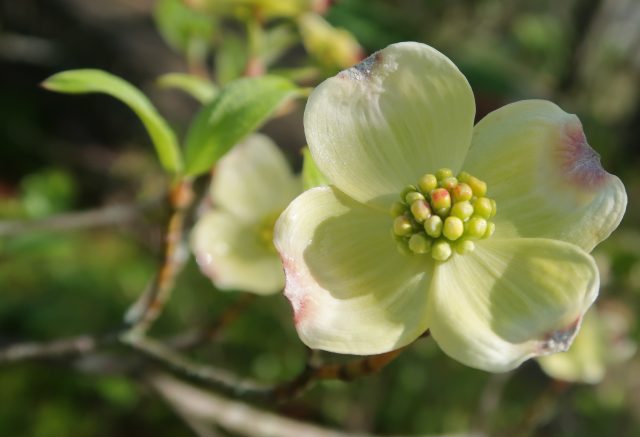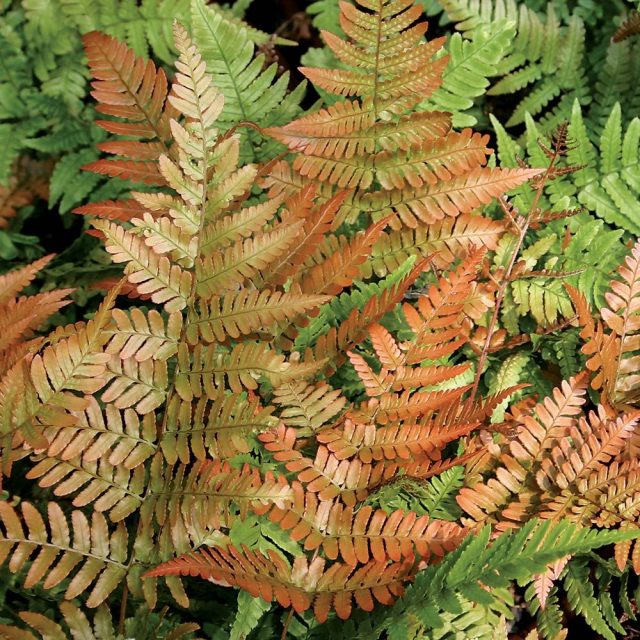Tips for Growing Happy Dogwood Trees
Publish Date: 4/15/21
The dogwood genus, Cornus, contains around 40 species and many cultivars of deciduous trees and shrubs, mainly of north temperate climates. Dogwoods are grown for their showy flowers, colorful bark, and their architectural, nearly horizontal branching pattern. The flowers are actually very small and are surrounded by larger bracts that range in color from white to dark pink (bracts are similar in appearance to petals, but they are modified leaves).
The Carell Dogwood Garden at Cheekwood is the centerpiece of our Nationally Accredited Cornus Collection®. By the first of April each year, the dogwoods at Cheekwood are providing pure joy to all that visit the 55-acre estate. In 1982, the original group of North American and Asian species was donated and planted in the Carell Dogwood Garden, aptly named for the family who generously gifted the collection. As the number of these woodland trees increased, so did their territory. Today, there is not a garden at Cheekwood without at least one dogwood to offer. Recognized and accredited by the Plant Collections Network of the American Public Garden Association in 2012, the botanical garden continues to maintain the dogwood collection to the highest standards. The following paragraphs include care tips used by Cheekwood’s very own garden staff to aid you in caring for the dogwood trees and shrubs within your collection.

Select Quality Materials
Starting with good, healthy material is the very first and the most important step for growing a beautiful dogwood. Fully inspect your tree candidates from limbs to root flares, ensuring there is no scarring on the trunk. This scarring could be a sign of freeze crack. If this is the case, the vascular system may be damaged, and the tree will have difficulty absorbing both water and nutrients. Check the crown for full healthy branches. If you see a lot of dead branches, keep on moving. Do the leaves look healthy? If you see a spots, blotches, and holes in many of the leaves, there could be a disease or pest issue involved. Does the tree have a strong central truck and an overall healthy appearance? Is it standing proud with good posture? It’s important to avoid a double trunk, if you can. Another thing to be aware of is any wire or string constricting the tree, as in the case of a ball and burlap tree. These should both be loose enough to slip your finger underneath. Check out the roots if you are able. Avoid trees that are girdled by roots that circle the trunk at soil level.
Thanks to the ground-breaking work Dr. Elwin Orton started decades ago at Rutgers University, many disease and insect resistant varieties of dogwoods can be found at your local garden center. These cultivars are hybrids made between our native dogwood (C. florida), Pacific dogwood (C. nuttallii) and the Asian species, C. kousa. Woody plants expert, Dr. Michael Dirr rates Aurora®, Celestial™, and Constellation® as the best of the original Rutgers hybrids.

Choose the Best Site & Adopt the Best Practices
North American dogwood trees (C. florida) are understory plants and are happiest growing beneath larger canopy trees. They perform best when growing in a partially shady spot with filtered, dappled light. Cornus kousa blooms more prolifically in full sun but will tolerate shade. Required sun exposure often depends on the site’s climate. A Cornus florida tree may be able to withstand more sun in a milder versus a warmer climate.
Both species need well drained soils and cannot withstand wet feet. Soil rich in acidic organic material is a bonus as it acts as mulch, keeping roots cool while offering the perfect, balanced nutrition. Test the pH of your soil to determine the acidity. If an increase in acidity is needed, simply apply a solution marketed for hollies and rhododendrons. Keep in mind that too much nitrogen can inhibit flower production. And never fertilize a young tree during its first year in the ground. It will be too sensitive while adjusting to its new home. Dogwoods do not tolerate extremes well. Intense heat, drought, and cold will increase the tree’s predisposition to disease and insect attacks.

Be Aware of Dogwood Threats: Anthracnose and Borer
Anthracnose poses a serious threat to dogwoods, especially ones in susceptible situations. unhealthy. The specific anthracnose that attacks dogwoods is caused by the fungus Discula destructive. The first signs of infection will normally occur during spring on flower bracts and leaves. Spots appear on leaves and flower bracts first and can be identified by their purple edges. The leaves themselves will present dry leaf margins. Leaves can also droop and take on a grayish color. As the disease persists into other parts of the tree, cankers will develop. These cankers are what cause the ultimate demise of the tree, by girdling and eventually cutting off the passageway of nutrients.
The best measures in fighting anthracnose are preventative ones. However, if the disease is discovered before branch dieback, systemic control may be effective.
Consider these 5 good practices to keep your dogwoods in check:
- Prune and dispose of any dead or diseased branches and twigs as well as water sprouts.
- Keep the fallen leaves raked and do not leave dead leaves attached to the tree.
- Improve air circulation and light penetration by pruning crossing branches and adequately spacing companion plants.
- Avoid fertilizing with high nitrogen solutions.
- If using a preventative fungicide spray, apply at bud break in early spring. Maintain a protective covering of fungicide when new growth is present.
It is the larvae of the clearwing moth that can cause devastating damage to dogwood as well as many other ornamental trees by boring into the wood cambium. Knotty, gall-like protrusions appear on the tree trunk after infestation has taken place. The same preventative measures for the anthracnose also apply to dogwood borer. Keep in mind that any physical injury to the tree is an open invitation to disease and pests. Avoid mowing and using other landscape equipment close to trees. Place wire cages around young tree trunks to protect from deer who will rub their antlers against the wood, marking “their” territory. Protecting young trees from wind damage by staking or bracing will also help reduce breakage and damage.

Dogwood Friends – Good Companion Plants
Interplanting shade-loving plants will enhance the beauty of your dogwoods by providing complimentary textures and color, adding depth and prolonged horticultural interest. Native azaleas come in a wide range of bright hues and coincide with the timing of Cornus florida blooms. Ferns, both evergreen and winter dormant, provide the perfect long-lasting groundcover by carpeting the woodland floor with a vast array of textures in multiple shades of greens and even corals. Hydrangeas offer pinks, blues, purples and whites later in the summer. Adding pockets of little treasures such as ginger (Asarum canadensis), trillium, and barrenwort (Epimedium sp.) further amps up the overall ambiance of the dogwood garden.
There is a long list of different shade plants that make great companion plants for dogwoods. Many of these, along with Cornus varieties that have been bred over the years, are represented along the Carell Dogwood promenade, hydrangea trail, and elsewhere around the estate. Be sure to catch the dogwoods in bloom every April through May to experience the full effect of spring at Cheekwood!

Learn more about the history of the Carell Dogwood Garden here, and check out our dogwood collection in bloom this weekend during our annual Dogs and Dogwoods event!